Home / The Hofmann Elimination
Amines
The Hofmann Elimination
Last updated: April 18th, 2025 |
The Hofmann Elimination Of Alkylammonium Salts: Examples and Mechanism
- The Hofmann Elimination is an elimination reaction of alkylammonium salts that forms C-C double bonds [pi bonds]. [Note 1] It proceeds through a concerted E2 mechanism.
- In contrast with most elimination reactions that make alkenes, which follow the Zaitsev (Saytzeff) rule, the Hofmann elimination tends to provide the less substituted alkene.
- In this post we go through the difference between Hofmann elimination and Zaitsev elimination and explain the key features in the Hofmann degradation mechanism that result in its preference for the “less substituted” alkene.
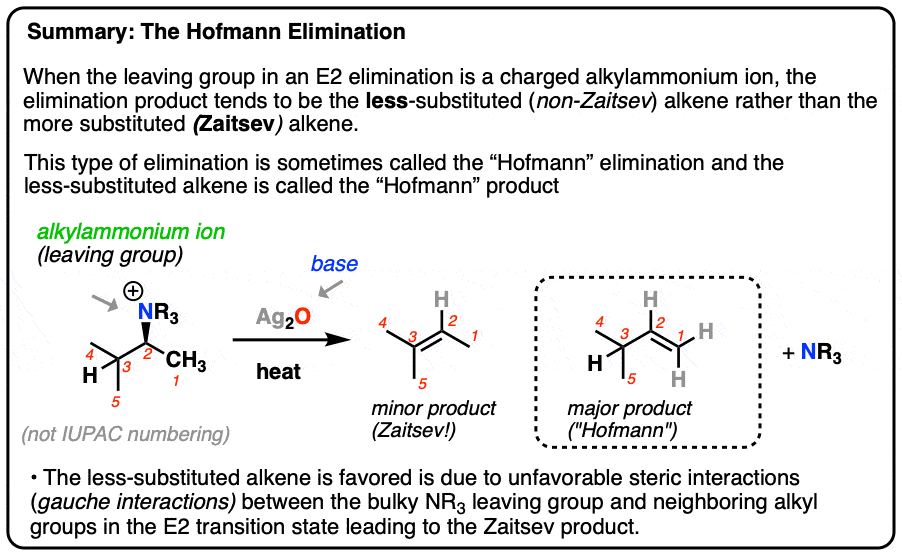
Table of Contents
- Quick Review: Zaitsev’s Rule
- “Non-Zaitsev” Products Can Dominate When Sufficient Steric Hindrance Is Present
- The “Hofmann Degradation”
- The Hofmann Elimination Has An Extremely Bulky Leaving Group, And This Leads To “Non-Zaitsev” Elimination Products
- Summary: The Hofmann Elimination
- Notes
- Quiz Yourself!
- (Advanced) References and Further Reading
1. Quick Review: Zaitsev’s Rule
Conventional elimination reactions that occur via the E2 mechanism follow Zaitsev’s rule. The major product will be the more substituted alkene (that is, the alkene with the most carbons directly attached to the alkene).
For instance in the first example below, the “trisubstituted” alkene is favoured over the “mono-substituted” alkene.
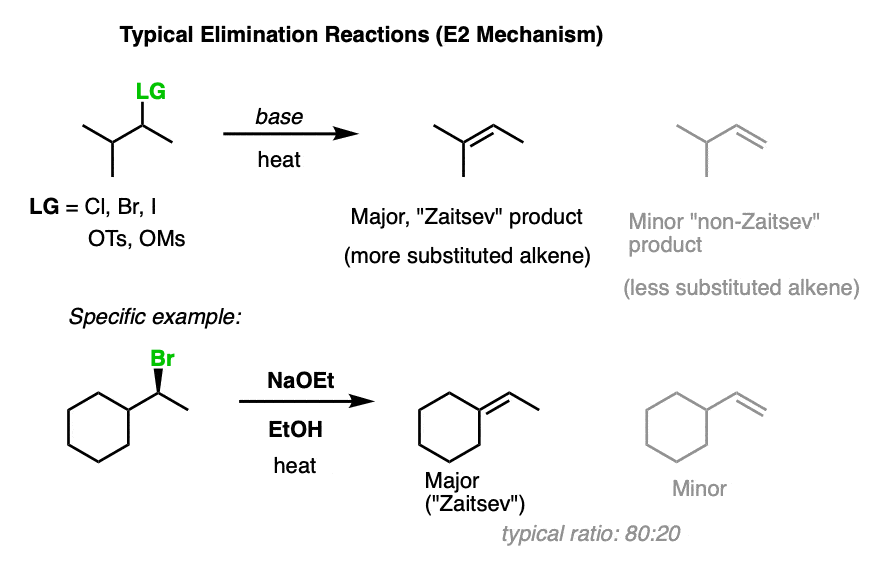
Why? The thermodynamic stability of alkenes increases in the order
mono-substituted < disubstituted < trisubstituted <tetrasubstituted. (For more, see post on Alkene Stability)
The energy differences are quite small – about 2 kcal/mol, but that’s enough to deliver an 80:20 ratio of products! [How do we know this? It can be obtained by plugging 2 kcal/mol into the equation ln K = –ΔG/RT]
2. “Non-Zaitsev” Products Can Dominate When Sufficient Steric Hindrance Is Present
Sometimes “non-Zaitsev” products can be obtained through the use of a bulky base for the elimination reaction. A classic example is to use sodium or potassium t-butoxide (KOt-Bu); another is to use lithium di-isopropyl amide (LDA). The idea here is that the bulky base will react more quickly with the least sterically hindered proton on a beta-carbon, which results in formation of the least substituted alkene. [for more, see: Bulky Bases In Elimination Reactions].
You sometimes might see these “non-Zaitsev” products be referred to as “Hofmann products”. Why?
Back to amines.
3. The “Hofmann Degradation”
Back in 1851, not many techniques for analyzing complex molecules were available. One method for determining the structure of an unknown compound was to break it down into simpler pieces and look for clues in the fragments, a process called degradation. August Wilhelm von Hofmann developed a two-step degradation method for amines that was later to bear his name.
The first step is to treat an amine with a vast excess of methyl iodide [CH3I], which results in an ammonium salt [we saw this reaction, “exhaustive methylation”, in a previous post].
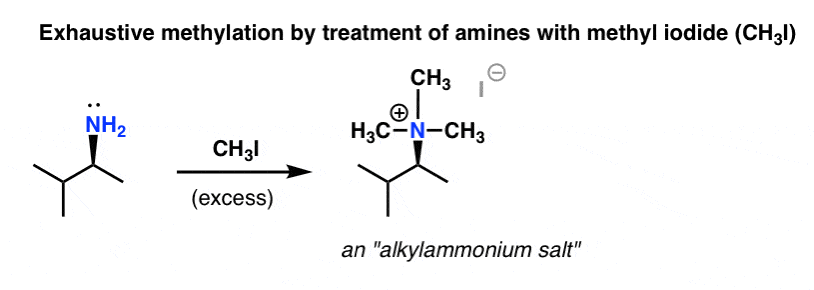
The second step is to distill the ammonium salt under low pressure in the presence of a strong base. Silver oxide (Ag2O) is often used.
It might not immediately look like it, but tertiary amines ( :NR3 ) are relatively weak bases (pKaH = 10) and therefore decent leaving groups. [recall that good leaving groups = weak bases]
Heating with strong base results in an elimination reaction: NR3 is lost and and a new alkene is formed.
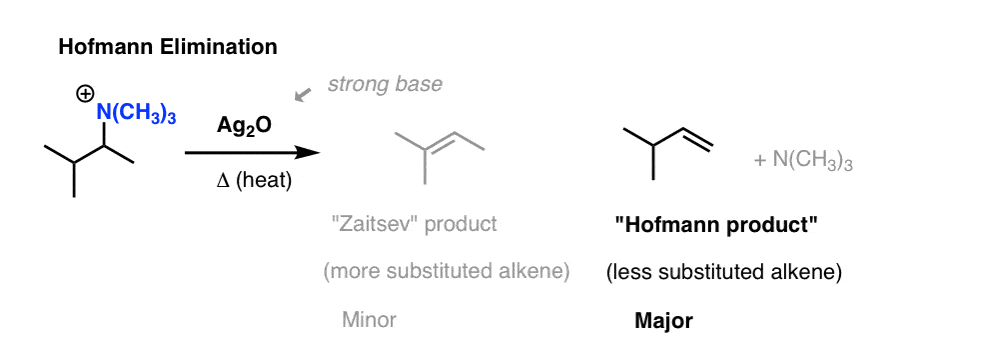
The interesting observation here is that the alkene product from this process tends to be the least substituted alkene (“Hofmann product”) not the Zaitsev product.
What’s going on?
4. The Hofmann Elimination Has An Extremely Bulky Leaving Group, And This Leads To “Non-Zaitsev” Elimination Products
It’s not that there’s something about the product alkene that makes it more stable than the Zaitsev product (it isn’t).
The answer lies in the relative energies of the transition states leading to the two products.
It might help to look at the mechanism for the reaction again. Recall that the E2 mechanism demands an antiperiplanar (180°) arrangement of the C-H and C-LG bonds.
It really helps to visualize this by drawing out Newman projections. When we do that, what do you notice?
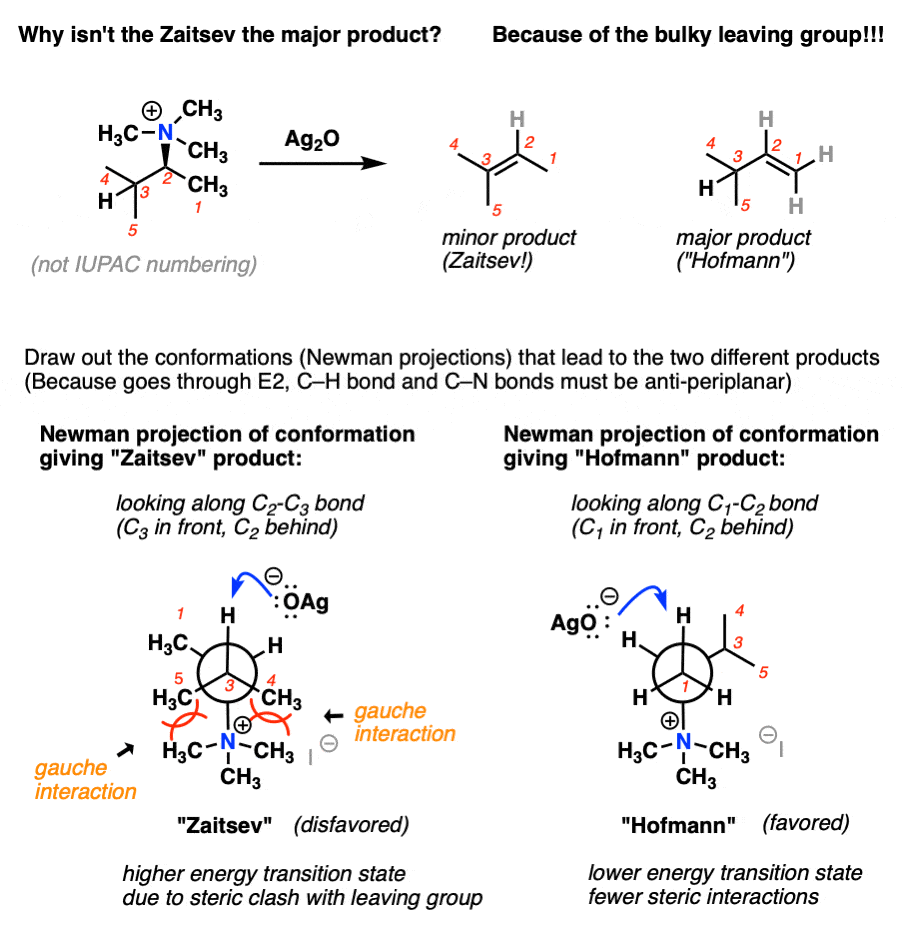
For most elimination reactions, the steric hindrance of the leaving group isn’t a factor we need to consider. Even though leaving groups like I and Br have a large Van Der Waals radius, their bonds to carbon are long, and being single atoms they don’t interfere with adjacent groups.
Contrast that to the NR3 group, which is like a big-ass ceiling fan spinning around its three alkyl groups – and each of the alkyl groups themselves is like a mini-ceiling fan spinning around three hydrogen atoms. It takes up a lot of space!
The conformation that leads to the “Zaitsev” product has a lot more steric hindrance (two gauche interactions!) than the conformation that leads to the “Hofmann” product, because of the extremely bulky N(CH3)3 leaving group!
These extra steric interactions are enough to disfavour the Zaitsev transition state relative to the Hofmann transition state, and lead to the Hofmann product as the major product.
5. Summary: The Hofmann Elimination
The Hofmann elimination is just another example of how tweaking a single variable in a chemical reaction can flip the outcome. We saw earlier how increasing the steric hindrance of the base can lead to the non-Zaitsev product. Here, we’re increasing the steric hindrance of the leaving group.
A few kcal/mol difference in a transition state might not sound like a lot, but it’s more than enough to change the identity of the major product. This is what makes organic chemistry so frustrating to beginners… yet also so deeply interesting!
Notes
Related Articles
- The Hofmann and Curtius Rearrangements
- The E2 Mechanism
- E1cB – Elimination (Unimolecular) Conjugate Base
- Elimination Reactions (2): The Zaitsev Rule
- Alkylation of Amines (Sucks!)
- Hofmann elimination of alkylammonium salts to give alkenes (MOC Reaction Guide)
- Amine Practice Questions (MOC Membership)
- Bulky Bases in Elimination Reactions
Note 1. Not strictly limited to ammonium salts. There are also examples of “Hofmann-type” eliminations with phosphonium (PR3+) leaving groups as well.
Quiz Yourself!
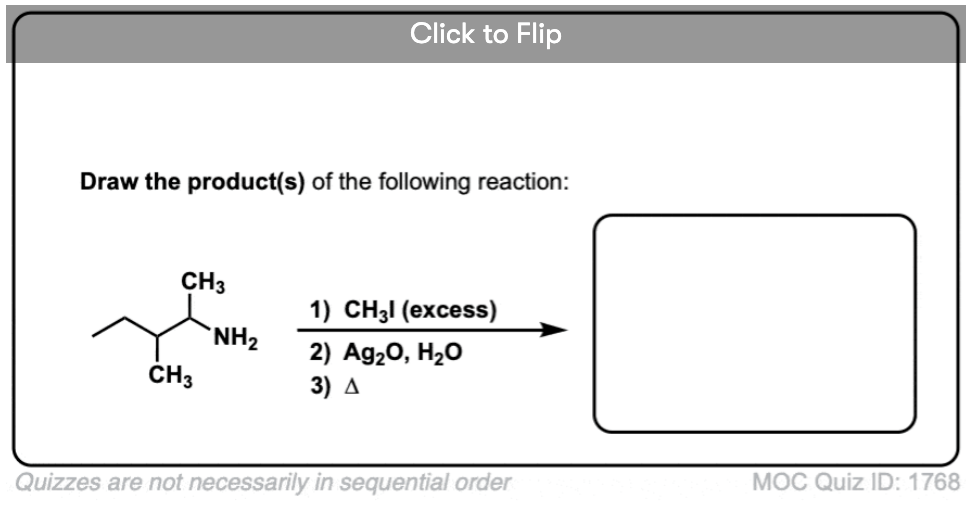
Become a MOC member to see the clickable quiz with answers on the back.
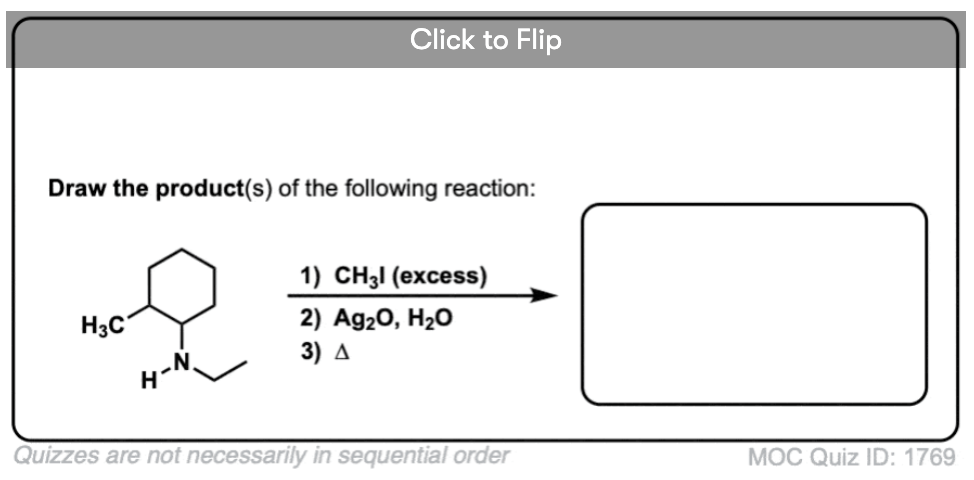
Become a MOC member to see the clickable quiz with answers on the back.
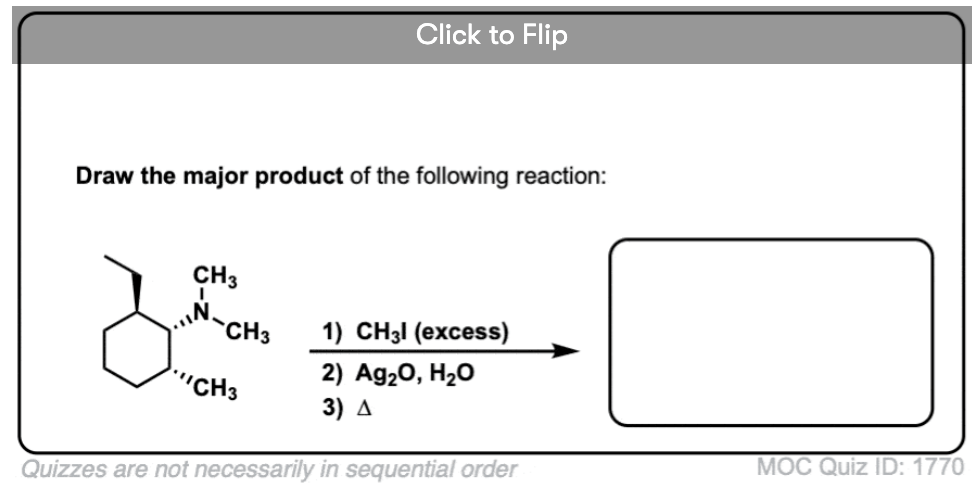
Become a MOC member to see the clickable quiz with answers on the back.
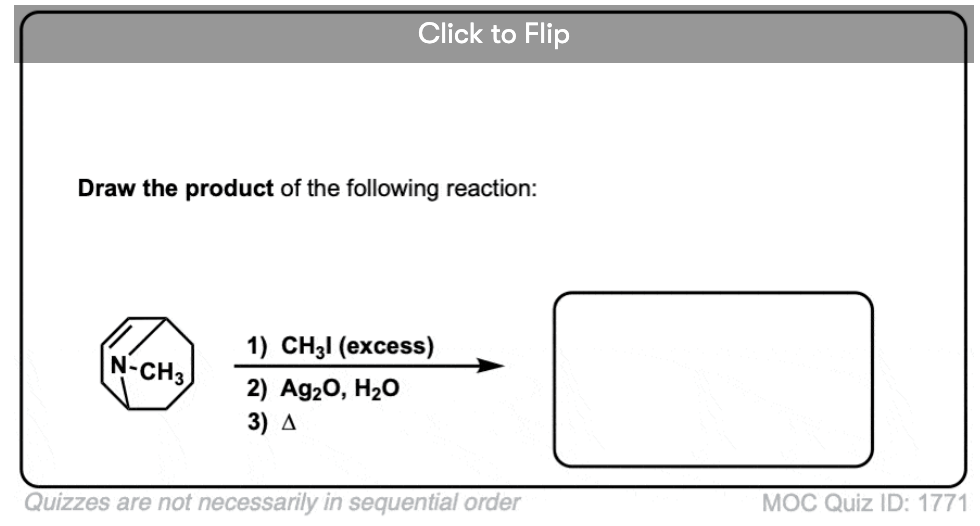
Become a MOC member to see the clickable quiz with answers on the back.
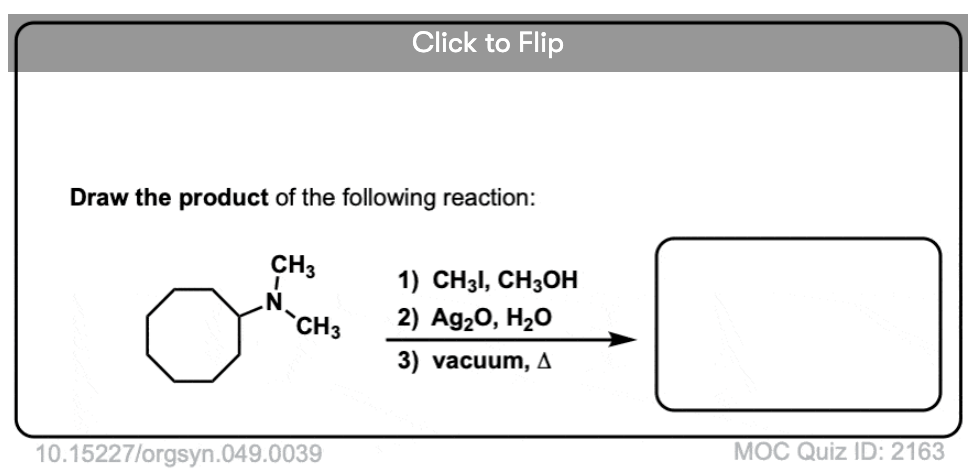
Become a MOC member to see the clickable quiz with answers on the back.
(Advanced) References And Further Reading
- Einwirkung der Wärme auf die Ammoniumbasen
W. Hofmann
Chem. Ber. 1881, 14 (1), 659-669
DOI: 10.1002/cber.188101401148
The original paper by W. Hofmann on a new method for olefin synthesis. He was a very productive organic chemist in the 19th century and his name has been attached to a variety of transformations, including amide degradation, isonitrile synthesis, and a few others.
- Olefins from Amines: The Hofmann Elimination Reaction and Amine Oxide Pyrolysis
Cope, Arthur C.; Trumbull, Elmer R.
Org. React. 1960, 11, 317-493
DOI: 10.1002/0471264180.or011.05
Organic Reactions, published and maintained by the ACS division of Organic Chemistry, is a source of comprehensive reviews on various transformations in organic chemistry. This particular review is written by Prof. Cope (MIT, of the Cope rearrangement). Detailed experimental procedures are provided towards the end. - Hofmann-Type Elimination in the Efficient N-Alkylation of Azoles: Imidazole and Benzimidazole
András Horváth
Synthesis 1994; 1994 (1): 102-106
DOI: 1055/s-1994-25414
Alkylation of cyanoethyl-substituted azoles followed by heating with a strong base yields acrylonitrile via a Hofmann elimination. - Cyclization in the Course of Clarke—Eschweiler Methylation
Arthur C. Cope and W. Dickinson Burrows
The Journal of Organic Chemistry 1965 30 (7), 2163-2165
DOI: 1021/jo01018a011
Two Hofmann eliminations are indicated in this paper, with compounds 5 and 7.
00 General Chemistry Review
01 Bonding, Structure, and Resonance
- How Do We Know Methane (CH4) Is Tetrahedral?
- Hybrid Orbitals and Hybridization
- How To Determine Hybridization: A Shortcut
- Orbital Hybridization And Bond Strengths
- Sigma bonds come in six varieties: Pi bonds come in one
- A Key Skill: How to Calculate Formal Charge
- The Four Intermolecular Forces and How They Affect Boiling Points
- 3 Trends That Affect Boiling Points
- How To Use Electronegativity To Determine Electron Density (and why NOT to trust formal charge)
- Introduction to Resonance
- How To Use Curved Arrows To Interchange Resonance Forms
- Evaluating Resonance Forms (1) - The Rule of Least Charges
- How To Find The Best Resonance Structure By Applying Electronegativity
- Evaluating Resonance Structures With Negative Charges
- Evaluating Resonance Structures With Positive Charge
- Exploring Resonance: Pi-Donation
- Exploring Resonance: Pi-acceptors
- In Summary: Evaluating Resonance Structures
- Drawing Resonance Structures: 3 Common Mistakes To Avoid
- How to apply electronegativity and resonance to understand reactivity
- Bond Hybridization Practice
- Structure and Bonding Practice Quizzes
- Resonance Structures Practice
02 Acid Base Reactions
- Introduction to Acid-Base Reactions
- Acid Base Reactions In Organic Chemistry
- The Stronger The Acid, The Weaker The Conjugate Base
- Walkthrough of Acid-Base Reactions (3) - Acidity Trends
- Five Key Factors That Influence Acidity
- Acid-Base Reactions: Introducing Ka and pKa
- How to Use a pKa Table
- The pKa Table Is Your Friend
- A Handy Rule of Thumb for Acid-Base Reactions
- Acid Base Reactions Are Fast
- pKa Values Span 60 Orders Of Magnitude
- How Protonation and Deprotonation Affect Reactivity
- Acid Base Practice Problems
03 Alkanes and Nomenclature
- Meet the (Most Important) Functional Groups
- Condensed Formulas: Deciphering What the Brackets Mean
- Hidden Hydrogens, Hidden Lone Pairs, Hidden Counterions
- Don't Be Futyl, Learn The Butyls
- Primary, Secondary, Tertiary, Quaternary In Organic Chemistry
- Branching, and Its Affect On Melting and Boiling Points
- The Many, Many Ways of Drawing Butane
- Wedge And Dash Convention For Tetrahedral Carbon
- Common Mistakes in Organic Chemistry: Pentavalent Carbon
- Table of Functional Group Priorities for Nomenclature
- Summary Sheet - Alkane Nomenclature
- Organic Chemistry IUPAC Nomenclature Demystified With A Simple Puzzle Piece Approach
- Boiling Point Quizzes
- Organic Chemistry Nomenclature Quizzes
04 Conformations and Cycloalkanes
- Staggered vs Eclipsed Conformations of Ethane
- Conformational Isomers of Propane
- Newman Projection of Butane (and Gauche Conformation)
- Introduction to Cycloalkanes
- Geometric Isomers In Small Rings: Cis And Trans Cycloalkanes
- Calculation of Ring Strain In Cycloalkanes
- Cycloalkanes - Ring Strain In Cyclopropane And Cyclobutane
- Cyclohexane Conformations
- Cyclohexane Chair Conformation: An Aerial Tour
- How To Draw The Cyclohexane Chair Conformation
- The Cyclohexane Chair Flip
- The Cyclohexane Chair Flip - Energy Diagram
- Substituted Cyclohexanes - Axial vs Equatorial
- Ranking The Bulkiness Of Substituents On Cyclohexanes: "A-Values"
- Cyclohexane Chair Conformation Stability: Which One Is Lower Energy?
- Fused Rings - Cis-Decalin and Trans-Decalin
- Naming Bicyclic Compounds - Fused, Bridged, and Spiro
- Bredt's Rule (And Summary of Cycloalkanes)
- Newman Projection Practice
- Cycloalkanes Practice Problems
05 A Primer On Organic Reactions
- The Most Important Question To Ask When Learning a New Reaction
- Curved Arrows (for reactions)
- Nucleophiles and Electrophiles
- The Three Classes of Nucleophiles
- Nucleophilicity vs. Basicity
- What Makes A Good Nucleophile?
- What Makes A Good Leaving Group?
- 3 Factors That Stabilize Carbocations
- Equilibrium and Energy Relationships
- 7 Factors that stabilize negative charge in organic chemistry
- 7 Factors That Stabilize Positive Charge in Organic Chemistry
- What's a Transition State?
- Hammond's Postulate
- Learning Organic Chemistry Reactions: A Checklist (PDF)
- Introduction to Oxidative Cleavage Reactions
06 Free Radical Reactions
- Bond Dissociation Energies = Homolytic Cleavage
- Free Radical Reactions
- 3 Factors That Stabilize Free Radicals
- What Factors Destabilize Free Radicals?
- Bond Strengths And Radical Stability
- Free Radical Initiation: Why Is "Light" Or "Heat" Required?
- Initiation, Propagation, Termination
- Monochlorination Products Of Propane, Pentane, And Other Alkanes
- Selectivity In Free Radical Reactions
- Selectivity in Free Radical Reactions: Bromination vs. Chlorination
- Halogenation At Tiffany's
- Allylic Bromination
- Bonus Topic: Allylic Rearrangements
- In Summary: Free Radicals
- Synthesis (2) - Reactions of Alkanes
- Free Radicals Practice Quizzes
07 Stereochemistry and Chirality
- Types of Isomers: Constitutional Isomers, Stereoisomers, Enantiomers, and Diastereomers
- How To Draw The Enantiomer Of A Chiral Molecule
- How To Draw A Bond Rotation
- Introduction to Assigning (R) and (S): The Cahn-Ingold-Prelog Rules
- Assigning Cahn-Ingold-Prelog (CIP) Priorities (2) - The Method of Dots
- Enantiomers vs Diastereomers vs The Same? Two Methods For Solving Problems
- Assigning R/S To Newman Projections (And Converting Newman To Line Diagrams)
- How To Determine R and S Configurations On A Fischer Projection
- The Meso Trap
- Optical Rotation, Optical Activity, and Specific Rotation
- Optical Purity and Enantiomeric Excess
- What's a Racemic Mixture?
- Chiral Allenes And Chiral Axes
- Stereochemistry Practice Problems and Quizzes
08 Substitution Reactions
- Nucleophilic Substitution Reactions - Introduction
- Two Types of Nucleophilic Substitution Reactions
- The SN2 Mechanism
- Why the SN2 Reaction Is Powerful
- The SN1 Mechanism
- The Conjugate Acid Is A Better Leaving Group
- Comparing the SN1 and SN2 Reactions
- Polar Protic? Polar Aprotic? Nonpolar? All About Solvents
- Steric Hindrance is Like a Fat Goalie
- Common Blind Spot: Intramolecular Reactions
- Substitution Practice - SN1
- Substitution Practice - SN2
09 Elimination Reactions
- Elimination Reactions (1): Introduction And The Key Pattern
- Elimination Reactions (2): The Zaitsev Rule
- Elimination Reactions Are Favored By Heat
- Two Elimination Reaction Patterns
- The E1 Reaction
- The E2 Mechanism
- E1 vs E2: Comparing the E1 and E2 Reactions
- Antiperiplanar Relationships: The E2 Reaction and Cyclohexane Rings
- Bulky Bases in Elimination Reactions
- Comparing the E1 vs SN1 Reactions
- Elimination (E1) Reactions With Rearrangements
- E1cB - Elimination (Unimolecular) Conjugate Base
- Elimination (E1) Practice Problems And Solutions
- Elimination (E2) Practice Problems and Solutions
10 Rearrangements
11 SN1/SN2/E1/E2 Decision
- Identifying Where Substitution and Elimination Reactions Happen
- Deciding SN1/SN2/E1/E2 (1) - The Substrate
- Deciding SN1/SN2/E1/E2 (2) - The Nucleophile/Base
- SN1 vs E1 and SN2 vs E2 : The Temperature
- Deciding SN1/SN2/E1/E2 - The Solvent
- Wrapup: The Key Factors For Determining SN1/SN2/E1/E2
- Alkyl Halide Reaction Map And Summary
- SN1 SN2 E1 E2 Practice Problems
12 Alkene Reactions
- E and Z Notation For Alkenes (+ Cis/Trans)
- Alkene Stability
- Alkene Addition Reactions: "Regioselectivity" and "Stereoselectivity" (Syn/Anti)
- Stereoselective and Stereospecific Reactions
- Hydrohalogenation of Alkenes and Markovnikov's Rule
- Hydration of Alkenes With Aqueous Acid
- Rearrangements in Alkene Addition Reactions
- Halogenation of Alkenes and Halohydrin Formation
- Oxymercuration Demercuration of Alkenes
- Hydroboration Oxidation of Alkenes
- m-CPBA (meta-chloroperoxybenzoic acid)
- OsO4 (Osmium Tetroxide) for Dihydroxylation of Alkenes
- Palladium on Carbon (Pd/C) for Catalytic Hydrogenation of Alkenes
- Cyclopropanation of Alkenes
- A Fourth Alkene Addition Pattern - Free Radical Addition
- Alkene Reactions: Ozonolysis
- Summary: Three Key Families Of Alkene Reaction Mechanisms
- Synthesis (4) - Alkene Reaction Map, Including Alkyl Halide Reactions
- Alkene Reactions Practice Problems
13 Alkyne Reactions
- Acetylides from Alkynes, And Substitution Reactions of Acetylides
- Partial Reduction of Alkynes With Lindlar's Catalyst
- Partial Reduction of Alkynes With Na/NH3 To Obtain Trans Alkenes
- Alkyne Hydroboration With "R2BH"
- Hydration and Oxymercuration of Alkynes
- Hydrohalogenation of Alkynes
- Alkyne Halogenation: Bromination, Chlorination, and Iodination of Alkynes
- Alkyne Reactions - The "Concerted" Pathway
- Alkenes To Alkynes Via Halogenation And Elimination Reactions
- Alkynes Are A Blank Canvas
- Synthesis (5) - Reactions of Alkynes
- Alkyne Reactions Practice Problems With Answers
14 Alcohols, Epoxides and Ethers
- Alcohols - Nomenclature and Properties
- Alcohols Can Act As Acids Or Bases (And Why It Matters)
- Alcohols - Acidity and Basicity
- The Williamson Ether Synthesis
- Ethers From Alkenes, Tertiary Alkyl Halides and Alkoxymercuration
- Alcohols To Ethers via Acid Catalysis
- Cleavage Of Ethers With Acid
- Epoxides - The Outlier Of The Ether Family
- Opening of Epoxides With Acid
- Epoxide Ring Opening With Base
- Making Alkyl Halides From Alcohols
- Tosylates And Mesylates
- PBr3 and SOCl2
- Elimination Reactions of Alcohols
- Elimination of Alcohols To Alkenes With POCl3
- Alcohol Oxidation: "Strong" and "Weak" Oxidants
- Demystifying The Mechanisms of Alcohol Oxidations
- Protecting Groups For Alcohols
- Thiols And Thioethers
- Calculating the oxidation state of a carbon
- Oxidation and Reduction in Organic Chemistry
- Oxidation Ladders
- SOCl2 Mechanism For Alcohols To Alkyl Halides: SN2 versus SNi
- Alcohol Reactions Roadmap (PDF)
- Alcohol Reaction Practice Problems
- Epoxide Reaction Quizzes
- Oxidation and Reduction Practice Quizzes
15 Organometallics
- What's An Organometallic?
- Formation of Grignard and Organolithium Reagents
- Organometallics Are Strong Bases
- Reactions of Grignard Reagents
- Protecting Groups In Grignard Reactions
- Synthesis Problems Involving Grignard Reagents
- Grignard Reactions And Synthesis (2)
- Organocuprates (Gilman Reagents): How They're Made
- Gilman Reagents (Organocuprates): What They're Used For
- The Heck, Suzuki, and Olefin Metathesis Reactions (And Why They Don't Belong In Most Introductory Organic Chemistry Courses)
- Reaction Map: Reactions of Organometallics
- Grignard Practice Problems
16 Spectroscopy
- Degrees of Unsaturation (or IHD, Index of Hydrogen Deficiency)
- Conjugation And Color (+ How Bleach Works)
- Introduction To UV-Vis Spectroscopy
- UV-Vis Spectroscopy: Absorbance of Carbonyls
- UV-Vis Spectroscopy: Practice Questions
- Bond Vibrations, Infrared Spectroscopy, and the "Ball and Spring" Model
- Infrared Spectroscopy: A Quick Primer On Interpreting Spectra
- IR Spectroscopy: 4 Practice Problems
- 1H NMR: How Many Signals?
- Homotopic, Enantiotopic, Diastereotopic
- Diastereotopic Protons in 1H NMR Spectroscopy: Examples
- 13-C NMR - How Many Signals
- Liquid Gold: Pheromones In Doe Urine
- Natural Product Isolation (1) - Extraction
- Natural Product Isolation (2) - Purification Techniques, An Overview
- Structure Determination Case Study: Deer Tarsal Gland Pheromone
17 Dienes and MO Theory
- What To Expect In Organic Chemistry 2
- Are these molecules conjugated?
- Conjugation And Resonance In Organic Chemistry
- Bonding And Antibonding Pi Orbitals
- Molecular Orbitals of The Allyl Cation, Allyl Radical, and Allyl Anion
- Pi Molecular Orbitals of Butadiene
- Reactions of Dienes: 1,2 and 1,4 Addition
- Thermodynamic and Kinetic Products
- More On 1,2 and 1,4 Additions To Dienes
- s-cis and s-trans
- The Diels-Alder Reaction
- Cyclic Dienes and Dienophiles in the Diels-Alder Reaction
- Stereochemistry of the Diels-Alder Reaction
- Exo vs Endo Products In The Diels Alder: How To Tell Them Apart
- HOMO and LUMO In the Diels Alder Reaction
- Why Are Endo vs Exo Products Favored in the Diels-Alder Reaction?
- Diels-Alder Reaction: Kinetic and Thermodynamic Control
- The Retro Diels-Alder Reaction
- The Intramolecular Diels Alder Reaction
- Regiochemistry In The Diels-Alder Reaction
- The Cope and Claisen Rearrangements
- Electrocyclic Reactions
- Electrocyclic Ring Opening And Closure (2) - Six (or Eight) Pi Electrons
- Diels Alder Practice Problems
- Molecular Orbital Theory Practice
18 Aromaticity
- Introduction To Aromaticity
- Rules For Aromaticity
- Huckel's Rule: What Does 4n+2 Mean?
- Aromatic, Non-Aromatic, or Antiaromatic? Some Practice Problems
- Antiaromatic Compounds and Antiaromaticity
- The Pi Molecular Orbitals of Benzene
- The Pi Molecular Orbitals of Cyclobutadiene
- Frost Circles
- Aromaticity Practice Quizzes
19 Reactions of Aromatic Molecules
- Electrophilic Aromatic Substitution: Introduction
- Activating and Deactivating Groups In Electrophilic Aromatic Substitution
- Electrophilic Aromatic Substitution - The Mechanism
- Ortho-, Para- and Meta- Directors in Electrophilic Aromatic Substitution
- Understanding Ortho, Para, and Meta Directors
- Why are halogens ortho- para- directors?
- Disubstituted Benzenes: The Strongest Electron-Donor "Wins"
- Electrophilic Aromatic Substitutions (1) - Halogenation of Benzene
- Electrophilic Aromatic Substitutions (2) - Nitration and Sulfonation
- EAS Reactions (3) - Friedel-Crafts Acylation and Friedel-Crafts Alkylation
- Intramolecular Friedel-Crafts Reactions
- Nucleophilic Aromatic Substitution (NAS)
- Nucleophilic Aromatic Substitution (2) - The Benzyne Mechanism
- Reactions on the "Benzylic" Carbon: Bromination And Oxidation
- The Wolff-Kishner, Clemmensen, And Other Carbonyl Reductions
- More Reactions on the Aromatic Sidechain: Reduction of Nitro Groups and the Baeyer Villiger
- Aromatic Synthesis (1) - "Order Of Operations"
- Synthesis of Benzene Derivatives (2) - Polarity Reversal
- Aromatic Synthesis (3) - Sulfonyl Blocking Groups
- Birch Reduction
- Synthesis (7): Reaction Map of Benzene and Related Aromatic Compounds
- Aromatic Reactions and Synthesis Practice
- Electrophilic Aromatic Substitution Practice Problems
20 Aldehydes and Ketones
- What's The Alpha Carbon In Carbonyl Compounds?
- Nucleophilic Addition To Carbonyls
- Aldehydes and Ketones: 14 Reactions With The Same Mechanism
- Sodium Borohydride (NaBH4) Reduction of Aldehydes and Ketones
- Grignard Reagents For Addition To Aldehydes and Ketones
- Wittig Reaction
- Hydrates, Hemiacetals, and Acetals
- Imines - Properties, Formation, Reactions, and Mechanisms
- All About Enamines
- Breaking Down Carbonyl Reaction Mechanisms: Reactions of Anionic Nucleophiles (Part 2)
- Aldehydes Ketones Reaction Practice
21 Carboxylic Acid Derivatives
- Nucleophilic Acyl Substitution (With Negatively Charged Nucleophiles)
- Addition-Elimination Mechanisms With Neutral Nucleophiles (Including Acid Catalysis)
- Basic Hydrolysis of Esters - Saponification
- Transesterification
- Proton Transfer
- Fischer Esterification - Carboxylic Acid to Ester Under Acidic Conditions
- Lithium Aluminum Hydride (LiAlH4) For Reduction of Carboxylic Acid Derivatives
- LiAlH[Ot-Bu]3 For The Reduction of Acid Halides To Aldehydes
- Di-isobutyl Aluminum Hydride (DIBAL) For The Partial Reduction of Esters and Nitriles
- Amide Hydrolysis
- Thionyl Chloride (SOCl2) And Conversion of Carboxylic Acids to Acid Halides
- Diazomethane (CH2N2)
- Carbonyl Chemistry: Learn Six Mechanisms For the Price Of One
- Making Music With Mechanisms (PADPED)
- Carboxylic Acid Derivatives Practice Questions
22 Enols and Enolates
- Keto-Enol Tautomerism
- Enolates - Formation, Stability, and Simple Reactions
- Kinetic Versus Thermodynamic Enolates
- Aldol Addition and Condensation Reactions
- Reactions of Enols - Acid-Catalyzed Aldol, Halogenation, and Mannich Reactions
- Claisen Condensation and Dieckmann Condensation
- Decarboxylation
- The Malonic Ester and Acetoacetic Ester Synthesis
- The Michael Addition Reaction and Conjugate Addition
- The Robinson Annulation
- Haloform Reaction
- The Hell–Volhard–Zelinsky Reaction
- Enols and Enolates Practice Quizzes
23 Amines
- The Amide Functional Group: Properties, Synthesis, and Nomenclature
- Basicity of Amines And pKaH
- 5 Key Basicity Trends of Amines
- The Mesomeric Effect And Aromatic Amines
- Nucleophilicity of Amines
- Alkylation of Amines (Sucks!)
- Reductive Amination
- The Gabriel Synthesis
- Some Reactions of Azides
- The Hofmann Elimination
- The Hofmann and Curtius Rearrangements
- The Cope Elimination
- Protecting Groups for Amines - Carbamates
- The Strecker Synthesis of Amino Acids
- Introduction to Peptide Synthesis
- Reactions of Diazonium Salts: Sandmeyer and Related Reactions
- Amine Practice Questions
24 Carbohydrates
- D and L Notation For Sugars
- Pyranoses and Furanoses: Ring-Chain Tautomerism In Sugars
- What is Mutarotation?
- Reducing Sugars
- The Big Damn Post Of Carbohydrate-Related Chemistry Definitions
- The Haworth Projection
- Converting a Fischer Projection To A Haworth (And Vice Versa)
- Reactions of Sugars: Glycosylation and Protection
- The Ruff Degradation and Kiliani-Fischer Synthesis
- Isoelectric Points of Amino Acids (and How To Calculate Them)
- Carbohydrates Practice
- Amino Acid Quizzes
25 Fun and Miscellaneous
- A Gallery of Some Interesting Molecules From Nature
- Screw Organic Chemistry, I'm Just Going To Write About Cats
- On Cats, Part 1: Conformations and Configurations
- On Cats, Part 2: Cat Line Diagrams
- On Cats, Part 4: Enantiocats
- On Cats, Part 6: Stereocenters
- Organic Chemistry Is Shit
- The Organic Chemistry Behind "The Pill"
- Maybe they should call them, "Formal Wins" ?
- Why Do Organic Chemists Use Kilocalories?
- The Principle of Least Effort
- Organic Chemistry GIFS - Resonance Forms
- Reproducibility In Organic Chemistry
- What Holds The Nucleus Together?
- How Reactions Are Like Music
- Organic Chemistry and the New MCAT
26 Organic Chemistry Tips and Tricks
- Common Mistakes: Formal Charges Can Mislead
- Partial Charges Give Clues About Electron Flow
- Draw The Ugly Version First
- Organic Chemistry Study Tips: Learn the Trends
- The 8 Types of Arrows In Organic Chemistry, Explained
- Top 10 Skills To Master Before An Organic Chemistry 2 Final
- Common Mistakes with Carbonyls: Carboxylic Acids... Are Acids!
- Planning Organic Synthesis With "Reaction Maps"
- Alkene Addition Pattern #1: The "Carbocation Pathway"
- Alkene Addition Pattern #2: The "Three-Membered Ring" Pathway
- Alkene Addition Pattern #3: The "Concerted" Pathway
- Number Your Carbons!
- The 4 Major Classes of Reactions in Org 1
- How (and why) electrons flow
- Grossman's Rule
- Three Exam Tips
- A 3-Step Method For Thinking Through Synthesis Problems
- Putting It Together
- Putting Diels-Alder Products in Perspective
- The Ups and Downs of Cyclohexanes
- The Most Annoying Exceptions in Org 1 (Part 1)
- The Most Annoying Exceptions in Org 1 (Part 2)
- The Marriage May Be Bad, But the Divorce Still Costs Money
- 9 Nomenclature Conventions To Know
- Nucleophile attacks Electrophile
27 Case Studies of Successful O-Chem Students
- Success Stories: How Corina Got The The "Hard" Professor - And Got An A+ Anyway
- How Helena Aced Organic Chemistry
- From a "Drop" To B+ in Org 2 – How A Hard Working Student Turned It Around
- How Serge Aced Organic Chemistry
- Success Stories: How Zach Aced Organic Chemistry 1
- Success Stories: How Kari Went From C– to B+
- How Esther Bounced Back From a "C" To Get A's In Organic Chemistry 1 And 2
- How Tyrell Got The Highest Grade In Her Organic Chemistry Course
- This Is Why Students Use Flashcards
- Success Stories: How Stu Aced Organic Chemistry
- How John Pulled Up His Organic Chemistry Exam Grades
- Success Stories: How Nathan Aced Organic Chemistry (Without It Taking Over His Life)
- How Chris Aced Org 1 and Org 2
- Interview: How Jay Got an A+ In Organic Chemistry
- How to Do Well in Organic Chemistry: One Student's Advice
- "America's Top TA" Shares His Secrets For Teaching O-Chem
- "Organic Chemistry Is Like..." - A Few Metaphors
- How To Do Well In Organic Chemistry: Advice From A Tutor
- Guest post: "I went from being afraid of tests to actually looking forward to them".
Why is silver oxide used in Hofmann Eliminations? Does the silver act as a catalyst somehow? Why are other cheaper bases not used instead?
By no means does Ag2O *have* to be used. It was used by Hoffmann, perhaps because the elimination was performed simply by adding base after alkylation and heating until the elimination product distilled off. Perhaps Ag+ helps to further destabilize the ammonium ion by making insoluble AgI, which speeds elimination, but I don’t believe there is anything magical about Ag2O.
I have a doubt. I read in Paula Bruice that Hoffman Elimination is preferred in highly electronegative or bulky groups like F or -NR3+ . The main reason is because when the base abstracts the proton from adjacent Carbon, the poor leaving tendency of these groups causes a carbanion to form at the adjacent Carbon (This is unlike the normal E1 and E2 elimination where either carbocation is formed or both H and leaving group leaves simultaneously) . So the T.S. for a Hoffman Elimination is basically a carbanion. As 1°>2°>3° , therefore the double bond is formed at less substituted position.
Now, my question arises “What if we add a -M, -I functional group to the adjacent carbon. Will the carbonion be stabilised and form the Zaitsev product even when the leaving group is NR3 ?”
Hello James,
My professor told us that in the last example, the Hofmann product would be major because the trimethylamine is positively charged, and because the tertiary CH is less “acidic” than the secondary CH (which means that the sec. gives its H+ more easily), we would have the Hofmann product (because in thisn case the positive charge would make this difference stronger).
Would you say that it is also a valid explanation? (He didn’t mention the steric reason of the leaving group though.)
Thanks in advance!
Hi Johann – that is a perfectly good explanation, and possibly a more rigorous one. The positively charged nitrogen is a strong electron withdrawing group, which increases acidity of the beta hydrogens. However the basicity of the tertiary hydrogen will be less, since it is made more electron-rich by its adjacent alkyl groups. The secondary will be more acidic. Also, there is a statistical contribution since there are two secondary hydrogens and only one tertiary hydrogen.
Could you please explain why this reaction too yields a Hofmann product?
I couldn’t paste the image here so here’s a drive link:
https://drive.google.com/open?id=1v-yTJP15O7qASQfIIYIEEUSKZo8hGirB
It’s from a reliable source (chem.libretexts) but I can’t bring myself to accept the outcome. Any hints towards the probable mechanism please?
Thanks in advance.
POCl3 gives a phosphate leaving group. Like the trialkylammonium leaving group, It is not unknown that the phosphate leaving group can have unfavorable interactions with the rest of the carbon chain leading to “anti Zaitsev” products instead of the normal “Zaitsev” product. One other example where it has been observed is in eliminations adjacent to the steroid nucleus, as shown by Djerassi and co-workers. See Giner, J.-L. et. al. J Org Chem. 1989 54 369. DOI . https://pubs.acs.org/doi/pdf/10.1021/jo00263a020 .
“Dehydration of 22-
(S)-alcohol 7 gave the 20(22) E olefin 8. However, dehydration of 22(f?)-alcohol 9 did not produce the 20(22) Z
olefin, but rather stigmasterol or brassicasterol i-methyl
ether (6) together with a product thought, based on the
mass spectrum, to be the 22-chloride. This result can be
rationalized on the basis of unfavorable steric interactions
in the transition state leading to the 20*2® product (Figure
3)”.
Figure 3 shows a Newman projection rationalizing the product.
75 year old danishefsky/stork student. Lilly scientist, Butler un organic lecturer
discovered sunday that stork had died at 95 yrs old.
he completed Germine synthesis by himself and wife in columbia lab at 95 yrs old.
reviewing his synthesis and found your web site;
love your teaching format
fun to review old woodward synthesis from 1958
I will keep your web site for quick reviews
thank you and best of luck to you.
Gary – it is an honor to have you as a reader. Thank you for stopping by.
Hi. I have a problem related to Hofmann Elimination . Can you help me this exercises?
It’s here
When the (R,R) isomer of the amine shown is treated with an excess of methyl iodide, then silver oxide, then heated, the major product is the Hofmann product.
(a) Draw the structure of the major (Hofmann) product.
(b) Some Zaitsev product is also formed. It has the (E) configuration. When the same amine is treated with MCPBA and heated, the Zaitsev product has the (Z) configuration. Use stereochemical drawings of the transition states to explain these observations.
( I can’t upload the picture of this exercise here so I upload it in google driver .this is link :
https://drive.google.com/file/d/1POFMh0Diw9-Qs_8d31HFsjnGtyje6nN7/view?usp=drivesdk